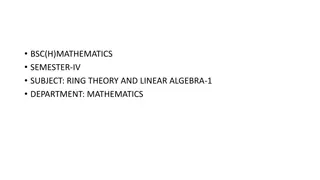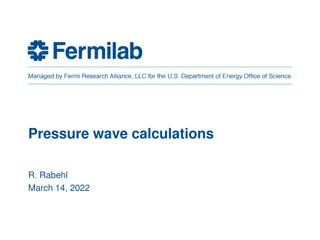Understanding Paycheck Calculations in Financial Algebra
Learn about different pay periods, hourly rates, and overtime calculations in financial algebra to ensure accurate paychecks. Explore examples of biweekly, semimonthly, and weekly pay calculations, as well as overtime rates. Understand how to determine annual salaries based on different pay frequencies and hourly wages.
Download Presentation

Please find below an Image/Link to download the presentation.
The content on the website is provided AS IS for your information and personal use only. It may not be sold, licensed, or shared on other websites without obtaining consent from the author. Download presentation by click this link. If you encounter any issues during the download, it is possible that the publisher has removed the file from their server.
E N D
Presentation Transcript
Section 5-2 Pay Periods and Hourly Rates Advanced Financial Algebra
What do you need to know to make sure each paycheck is correct? Employees are paid at different frequencies depending upon the company they work for. Some common options: Weekly = 52 paychecks per year (52 weeks in a year) Biweekly = 26 paychecks per year (every other week, same day) Semimonthly = 24 paychecks per year (twice each month for 12 months) Monthly = 12 paychecks per year (one per month, 12 months in a year) Direct deposit = your paycheck is automatically deposited electronically into your bank account. This can also save you money on bank fees each month. Overtime pay rate is usually 1.5 which is 1 times the regular hourly rate. Minimum wage (amount depends upon where you live) = lowest hourly rate that can be paid to an employee. In California, 2018, it is $10.50 for small companies and $11/hour for larger companies.
Example 1 biweekly paycheck Christina is paid biweekly. Her annual (yearly) salary is $37,000. What is her biweekly salary, rounded to the nearest cent? SOLUTION: There are 26 biweekly paychecks per year since she will be paid every other week. 37,000 /26 = $1,423.08 is her biweekly salary.
Example 2 - semimonthly Manny is paid semimonthly. His semimonthly salary is $1,239. What is his annual salary? SOLUTION: Manny received 24 paychecks per year since he is paid twice each month. $1,239 * 24 = $29,736 is his annual salary.
Example 3 weekly pay Maureen is a manager at a local restaurant. Her regular hourly wage is $15.70. If she regularly works 40 hours per week, what is her regular weekly pay? SOLUTION: $15.70 * 40 hours = $628 weekly pay
Example 4 - overtime If Maureen from Example #3 works overtime, she receives an hourly rate of 1 times her regular hourly rate. What is Maureen s hourly overtime rate? SOLUTION: $15.70 * 1.5 - $23.55 per hour overtime rate per hour
Example 5 more overtime Janice earns $16 per hour. If her regular hours are 40 hours per week, and she receives time-and-a-half (1 ) overtime, find her total pay for a week in which she works 45 hours. SOLUTION: $16 * 40 hours = $640 regular pay 45 hours total 40 regular hours = 5 overtime hours $16 * 1.5 (time-and-a-half) = $24 per overtime hour $24 * 5 overtime hours = $120 overtime pay only $640 regular pay + $120 overtime pay = $760 total pay for 45 hours of work
Example 6 hourly rate (backwards, using an equation) Sam is a waitress who worked 40 regular hours and 7 more overtime hours and her gross pay (before taxes and other withholdings) was $611.05. What was her regular hourly rate? SOLUTION: Regular pay + overtime pay = total pay 40 hours (x dollars per hour) + 7 hours (1.5x time-and-a-half) = $611.05 total 40x + 10.5x = $611.05 multiplied 7 times 1.5x 50.5x = $611.05 combined like terms x = $12.10 regular pay per hour divided both sides by 50.5
Example #8 salary increase/raise Michaela signed a 5-year contract for her new job and her starting salary is $67K ($67,000) per year. If she gets a good review of her work, at the end of each year, she will receive a 3% raise. What will her salary be in 5 years to the nearest dollar? SOLUTION: General equation is future salary = starting salary * (1 + raise)? 1 Michaela s salary in five years = $67,000 (1+ .03)5 1 no raise first year Michaela s salary in five years = $67,000 (1.03)4 Michaela s salary in five years $75,409 rounded to nearest dollar
Assignment: pg 303 #4, 5, 10, 12, 14, 16, 18, 22, 23, 26 (intro to spreadsheets), 28 4. 5. 10. 12. 14.
Assignment: pg 303 #4, 5, 10, 12, 14, 16, 18, 22, 23, 26 (intro to spreadsheets), 28 continued 16. 18. 22. Julianne works as a waitress. She earns $13 per hour plus tips. a. Today, she worked x hours. Express her pay for these hours algebraically using x. b. She served nine tables. The total bill for these nine tables was y dollars. Julianne receive 18% in tips from these bills. Express the amount she received in tips algebraically. c. Express Julianne s total earnings for the day algebraically.
Assignment: pg 303 #4, 5, 10, 12, 14, 16, 18, 22, 23, 26 (intro to spreadsheets), 28 continued 26. 28. Melissa has bought a $2 state lottery ticket every week for the past 20 years. This week, she won for the first time - $2,000. Compare these winnings to her total expenditures and explain whether or not it was worth it and why.























